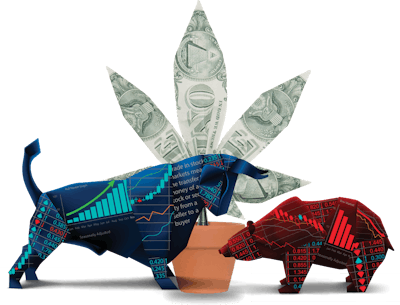
April 7, 2015, Kaya Holdings, Inc. (formerly Alternative Fuels Americas, Inc.) filed a Form 8-K with the Securities and Exchange Commission (the SEC), disclosing its new name and change in ticker symbol from AFAI to KAYS. In subsequent press releases and filings with the SEC, KAYS clarified it would engage in both growing and selling marijuana, making KAYS arguably the first seed-to-sale company to publicly report to the SEC under the Securities Exchange Act of 1934, as amended (the “Exchange Act”).
Cannabis Business Times covered this in-depth in its November 2015 issue (in the article “Going Public: What You Can Learn From Kaya Shack …,” accessible online at http://bit.ly/CBT16GoingPublic), and the feature raised questions for many legal cannabis cultivators and dispensaries about the SEC, the OTCQB (a venture marketplace for start-up and developing U.S. and international companies) and the possibility of uplisting to a national securities exchange (e.g. NASDAQ) when a company is related to a federally illegal product.
Despite KAYS’ accomplishment in reporting to the SEC, the company has yet to file a Form S-1 registration statement in its current incarnation for the registration of its securities under the Securities Act of 1933. Without such a registration statement, KAYS cannot offer and sell any free-trading shares to the public. Form S-1 is the registration statement mostly commonly used by public companies to register their common stock for sale to the public, including when conducting an initial public offering (“IPO”) of its securities, so this will be the focus here (rather than other classes of securities, such as preferred stock or debt securities).
The situation in which KAYS finds itself is surprisingly common in the cannabis industry. While there are hundreds of public reporting companies with cannabis industry-related businesses, only a handful have effective registration statements (e.g., Form S-1) on file that allow them to offer and sell unrestricted shares of common stock to the public. Also, those companies with registration statements are almost all cannabis-adjacent businesses. However, this trend may be changing. On June 15, 2015, Terra Tech Corp. filed a resale Form S-1 registration statement that the SEC seems to have allowed to become effective. While Terra Tech Corp. started as a cannabis-adjacent business, it has pivoted to a business model that includes medical marijuana dispensaries.
This distinction between KAYS (without a Form S-1 on file with the SEC) and Terra Tech Corp. (with a number of effective Form S-1 Registration Statements on file with the SEC) begs the question whether a public reporting company (such as the multitude in the cannabis industry touting themselves as “public” companies) without a significant number of registered, free-trading shares of common stock (and accordingly, without the ability to fully tap the capital markets) can really be considered “public” companies.
What Does It Mean to Be “Public”?
A company is considered “public” when it has “public” shareholders — in other words, when members of the public own the company’s common stock, and the public can then freely sell their shares of common stock in the open market. Both the New York Stock Exchange (the NYSE) and NASDAQ require that a company have a certain (relatively large) number of these public shareholders before the company can list on these national exchanges.
Thus, even if a company provides information to the public by reporting to the SEC, either voluntarily or as a result of the requirements arising from filings with the SEC (described below), it is arguably not really a “public” company until it has built a shareholder base made up of members of the general public (that are not otherwise affiliated with the company).
Many cannabis companies (including KAYS) would not be considered public in this sense of the term, as they do not have shares registered for sale to the public. So how do these companies become “public?”
The Traditional Route to Going Public: IPO and Form S-1 Filing
Most companies go public through the initial public offering (“IPO”) process, with the assistance of an underwriter. After a successful IPO, a company is often able to raise substantial capital through sales of its common stock to the public in just a few days.
An aspect of IPOs that is not often discussed is that a successful IPO actually requires the filing of two registration statements in order for a company to go public (both of which require the company to periodically report to the SEC after filing):
1. Form 8-A, which registers a class of securities (such as common stock) under the Exchange Act, which is also the body of law that mandates periodic reports to the SEC, such as 10-Ks, 8-Ks and 10-Qs.
2. Form S-1, which registers individual securities in accordance with the Securities Act (such as shares of common stock) and allows the company to sell those individual securities to members of the public.
Once filed, these forms are subject to review and comment by the SEC. Once a company has amended its registration statements to the SEC’s satisfaction, and the SEC has no further comments, the company will file an acceleration request with the SEC in order for the company’s Form S-1 and corresponding Form 8-A to become effective on the date specified in the request (usually two business days after the request date).
At the end of this process and upon sales of its shares to the general public in the IPO, the company will be a “public” company in the fullest sense of the term.
As it is then truly “public,” the company will enjoy all the benefits of that status: substantial access to capital markets through the sale of its newly registered shares of common stock to the public; greater liquidity of its common stock; the ability to use its common stock as a form of capital (e.g., to fund acquisitions or corporate development); and the ability to use its securities for stock options and other employee-incentives.
Cannabis companies like KAYS have not gone through the traditional IPO process because of federal rules. But other options are available, such as the reverse merger (which Terra Tech Corp. used) and Rule 144 sales. In a future column, we’ll outline those options and how they compare to an IPO.
About the Author: Marc J. Adesso is a corporate finance and securities attorney at the AmLaw 100 law firm of Baker, Donelson, Bearman, Caldwell & Berkowitz, P.C. Previously, Adesso worked on Wall Street, where he counseled a wide array of public companies, including many that went public by alternative means, such as through the completion of a reverse merger. Currently, he concentrates his practice on securities, corporate finance, hedge fund management and business transactions, including mergers and acquisitions for primarily exchange-listed companies. Attorney Robert C. McCauley Williams, contributed to this article, and is also a corporate finance and securities attorney at Baker, Donelson, Bearman, Caldwell & Berkowitz, P.C.
















